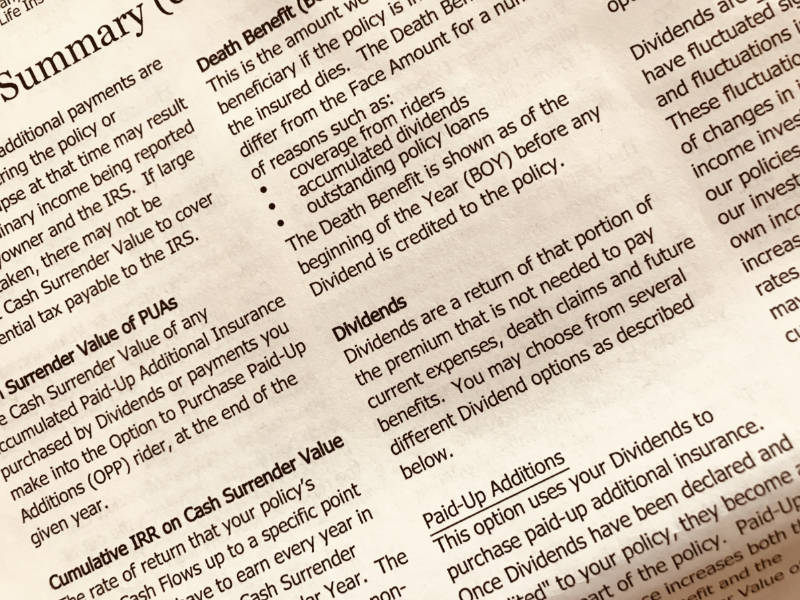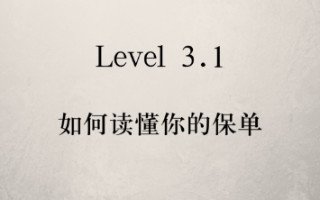人寿保险保单是您和保险公司签署的一份法律合同,一旦您在保单上签字,这就代表着您已清楚您的选择,认同这份协议。但如果您已经购买了保单,却仍有疑惑,美国人寿保险指南网的保单101知识栏目,也许可以帮助你解读。
您的保单是一份有法律效应的文件,里面有许多专业名词。通过本文的学习,我们将帮助你逐渐了解和掌握它。
每家保险公司的保单采取的排版,格式或术语等都可能不同,但核心部分是统一不变的。接下来是本文的知识要点:
- 声明部分
- 保单术语及解释
- 保单保障详情
声明部分
声明部分也被称为“保单简介”或叫“保单目录”,但它们其实是一回事:这部分概括了您和您保单的重要信息,通常包括以下内容:
- 被保人和保单持有人姓名:这通常是同一个人——您,但您也可以为其他人投保,在这种状况下,您是保单持有人,而对方是被保人。举例来说,比如妈妈作为保单持有人,为子女投保。
- 保单类型:是定期寿险(Term),还是Whole Life,UL ,GUL或IUL等终身寿险。
- 保单号:标志了您保单生效的号码
- 保单生效日期:您保单激活或生效的日期
- 用户评级或保费等级:保险公司根据您的体检、病历以及年龄给出的保费等级
- 定期保单年限:您保单的时限(只针对定期保险而言)
- 附约(Rider):您所有的附约将在这里列出,然后在保单后面饿部分里列出具体详情
保单术语及解释
这部分对保单里面用的一些专业名词做出了解释。学习保单里的专业名词,并在此基础上阅读保单内容里面的解释部分,能帮助您弄清楚保单中将会遇到的更复杂的专业术语。

以下这些专业名词,通常都会出现在保单中:
- 死亡赔偿/Death Benefit:您死亡后赔偿给您的受益人(们)的金额
- 受益人/Beneficiary:您保单的死亡赔偿的接受者。您的受益人可以是一个人,多人甚者是一个集体。您可选择您的死亡赔偿的去处和每个受益人受益的比例。
- 保单生效日期/保障期:您的保单从某一刻正式生效,在保障期内有效。如果您在保单有效期内身故,或触发赔偿条款,那么保险公司会为您支付理赔金。
- 保投保年龄:保单生效时您的年龄
- 保费/Premium:您为您的保险支付的费用
- 不参与分红/Non-participating:代表您的保单不会收到保险公司的分红
保单保障详情
这部分也被称为投保协议,本部分会用到上面提到专业名词和定义,来讲解保险公司对您的承诺内容。
保费和付款信息
这个部分会列出您的保费。对于保费固定不变的定期寿险保单来说,该部分会包含月费和年费。对作为理财规划目的,保费可能会变动的终生型人寿保单来说,该部分会展示一张随时间变动的保费表。
这部分也包括了关于宽限期(Grace period)的信息,宽限期是指一段时间长度。当你在保费账单日后还没有缴费,保单在这个宽限期内依然后效。这部分还可能包括重新恢复生效条款(Reinstatement terms),这部分将解答你在保单失效后如何重新让保单恢复生效。这个部分通会有例外条款,例如自杀条款,用来指出,如果您在保单生效内的两年内自杀,您将不会得到赔偿。
所有权和权利转移
本部分会详细解释保单所有权的变更或将普通保单转为终身类型保单的权利,以及终身类型的保单如何从一家公司转换到另一家公司。本节会让您了解您有哪些选择。
受益人
本部分会列出您选择在您死后接受您的死亡赔偿的个人,多人及集体。它也会为您的受益人提供理赔详情的概要,包含他们可以选择一次性还是分期支付这样的选项。
附约(Rider)
这部分详细写明了列在保单说明页上的附约。每个附约都会被完整地列在这里,包含了解释、例外情况和指南。以下是一些可能在您的保单中出现或常见的附约:
- 残疾人收入附约:如果您成为残疾人且无法继续工作,保单会给您提供收入
- 残疾人保费豁免附约:如果您成为残疾人,将豁免您的保费
- 定期寿险转换附约:允许你在定期寿险结束时将其转为终身寿险
- 提前支付死亡赔偿附约:如果您被诊断为患有绝症,保险公司可以提前支付全部或部分死亡赔偿。
- 长期护理附约:如上一条,如果您是重症病人,保险公司可以提前选择支付全部或部分死亡赔偿以支持您长期护理的开销
- 重大疾病附约:如果您被确证患有重大疾病,保险公司将支付一次性赔偿(从您的死亡赔偿中扣除)。
公司转移
这部分描述保单如何启动1035交换。1035交换是税法中的一项规定,允许您作为投保人,将资金从人寿保险,转移到新的保险公司,而无需缴纳税款。关于1035转换的具体说明,请点击该专栏文章了解。








